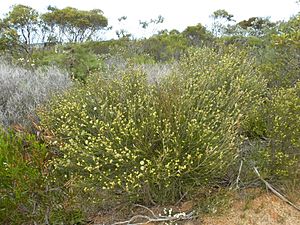Broombush facts for kids
Quick facts for kids Broombush |
|
|---|---|
 |
|
| M. uncinata growing 90 km west of Esperance | |
| Scientific classification | |
| Genus: |
Melaleuca
|
| Species: |
uncinata
|
Melaleuca uncinata, often called broombush, broom honeymyrtle, or brushwood, is a cool plant from the paperbark family. It grows naturally in southern Australia. People collect it from the wild and also grow it on special farms to make broombush fencing. The Noongar people, who are Aboriginal Australians, call this plant kwytyat and yilbarra.
Contents
What Broombush Looks Like
Broombush is a shrub with many stems that stays green all year. It usually grows less than 2 m (6 ft 7 in) tall. Sometimes, it can even become a small tree, reaching almost 5 m (16 ft) high. You often find it growing near mallee eucalypt trees.
Its leaves are long and thin, about 19–56 mm (0.75–2.20 in) long and less than 1.2 mm (0.047 in) wide. They are almost round and have a distinct curved hook at the end. These leaves also have special oil glands along their edges.
The flowers of the broombush can be white, cream, or yellow. Birds love them! They grow in tight, almost round bunches, about 15–17 mm (0.59–0.67 in) across, where the leaves meet the stem. Each bunch has many small groups of three flowers. The flowers have five bundles of stamens (the parts that make pollen), which are cream, white, or pale greenish-cream. Broombush flowers bloom from August to December. After the flowers, small fruits grow closely together, forming a cluster about 7–13 mm (0.3–0.5 in) wide.
How Broombush Got Its Name
The plant Melaleuca uncinata was first officially described in 1812 by a botanist named Robert Brown. He wrote about it in a book called Hortus Kewensis.
The second part of its scientific name, uncinata, comes from a Latin word. It means "bearing hooks" or "barbed." This name was chosen because of the hooked shape at the tip of the leaves.
Scientists sometimes study plants again to make sure they are correctly identified. In 1994, a scientist named Lyndley Craven looked closely at Melaleuca uncinata. He found that some groups of these plants were actually new species!
Where Broombush Grows
This type of melaleuca plant is found in several parts of southern Australia. You can see it in the Coolgardie-Esperance region of Western Australia. It also grows on the Eyre Peninsula in South Australia, and stretches east into western Victoria and south-western New South Wales.
Broombush and Other Plants
Melaleuca uncinata is special because it's the only known plant that hosts a very rare and endangered orchid. This orchid is called the Rhizanthella gardneri, and it's known as the "underground orchid" because it grows completely hidden beneath the ground!
How People Use Broombush
Building Things
For over 80 years, people in Australia have used the grey stems, twigs, and dry leaves of Melaleuca uncinata to make decorative brushwood fencing. Even though it's only a small part of the fencing market, it's an important use for these plants. People also use broombush to make garden furniture, small outdoor shelters called gazebos, and hanging baskets for plants. In 1994, about 600,000 bundles of brushwood were used in Australia, with each bundle weighing about 25 kilograms (55 lb).
Essential Oils
Scientists have studied the leaves of broombush to find out what kind of oils they contain. It turns out that different groups of broombush plants produce different types of oil. One group has an oil called 1,8-cineole as its main ingredient, while another group has terpinen-4-ol as its major component.
Images for kids
-
M. uncinata growing 90 km west of Esperance





